#giant pill millipede
Explore tagged Tumblr posts
Photo








Giant African pill millipede, Sphaerotherium giganteum, Sphaerotheriidae
Found in southern Africa
Photos 1-3 by jaheymans, 4 by bushboy, 5-6 by louws, and 7-8 by bushboy
#animals#curators on tumblr#bugs#myriapods#millipede#pill millipede#giant african pill millipede#giant pill millipede#one nice bug
1K notes
·
View notes
Text
Giant Emerald Pill-Millipede: when these enormous millipedes are all rolled up, their bodies can be as big as a baseball, a tennis ball, or a small orange
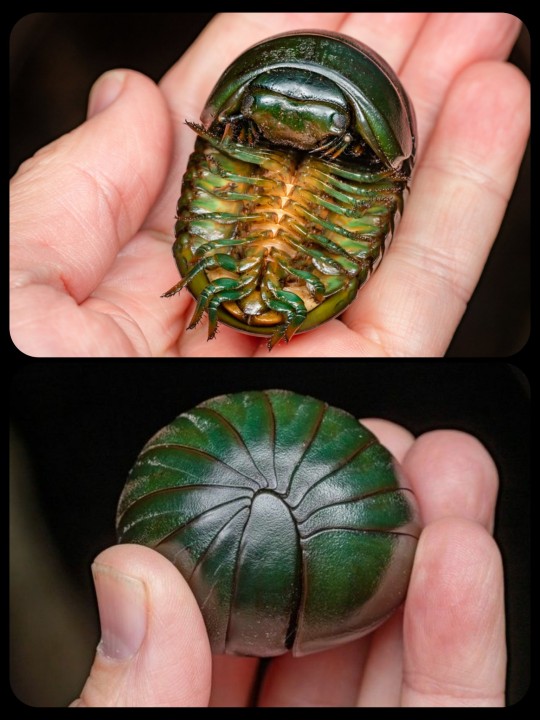
This species (Zoosphaerium neptunus) is commonly known as a giant emerald pill-millipede. The females can measure up to 90mm long (roughly 3.5 inches), making this the largest species of pill-millipede in the world.
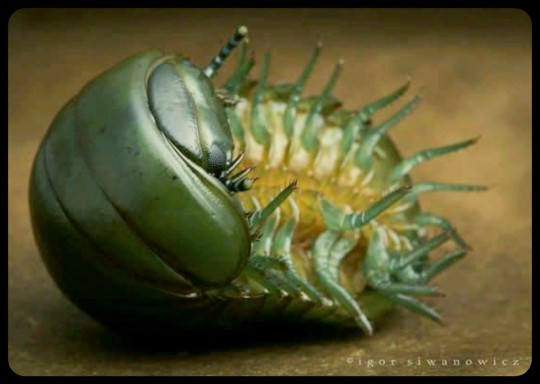
There is a significant degree of sexual dimorphism in this species, with the males measuring only about 45mm (1.8 inches) long -- roughly half the size of the females.
Giant emerald pill-millipedes are found only in Madagascar, which is home to several endemic species of giant pill-millipedes (order Sphaerotheriida). The Malagasy name for giant pill-millipedes is "Tainkintana," which means "shooting-star."

Pill-millipedes use conglobation as a defense mechanism, which means that they can curl their bodies up into a spherical shape so that their dorsal plates form a protective shield around the softer, more vulnerable parts of their bodies, just like an actual pill-bug or a "roly-poly."
When they roll themselves up completely, they look almost like gently polished chunks of malachite, emerald, or jade.
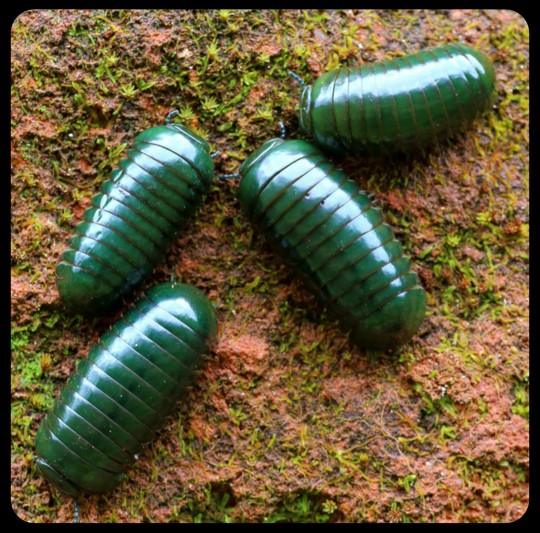
Giant emerald pill-millipedes will sometimes form large swarms that travel together as a group. This is the only species of giant pill-millipede that engages in any sort of swarming behavior, and the purpose of that behavior is still unclear. The swarms often contain thousands of individuals, with almost all of them moving in the same direction, even when there is no physical contact that might allow the millipedes to "herd" one another along.

Their swarming behavior also has some very peculiar features, as this article explains:
During swarming, Zoosphaerium neptunus individuals pay little attention to their surroundings; many specimens were observed walking straight into and drowning in small puddles. Some swarms even display ‘cliché lemming behaviour:' in Marojejy, a large part of a swarm walked into and drowned in a small river.
No single specimen was observed walking ‘against the current,' all specimens were moving in the same direction (southeast), even when not in contact with one another.
Of 273 randomly collected individuals, 105 were males, while 168 were females. The males were 8.3 - 14.1 mm wide (average width 10.4 mm). According to the inner horns of the posterior telopods, all males were sexually mature. The females were 9.95 - 15.4 mm wide (average width 11.4 mm). All females displayed non sclerotized vulvae and were sexually immature.
Some researchers argue that the swarming serves as a defense mechanism, providing a layer of protection (or at least some cryptic cover) against local predators, but the swarming behavior is still poorly understood.
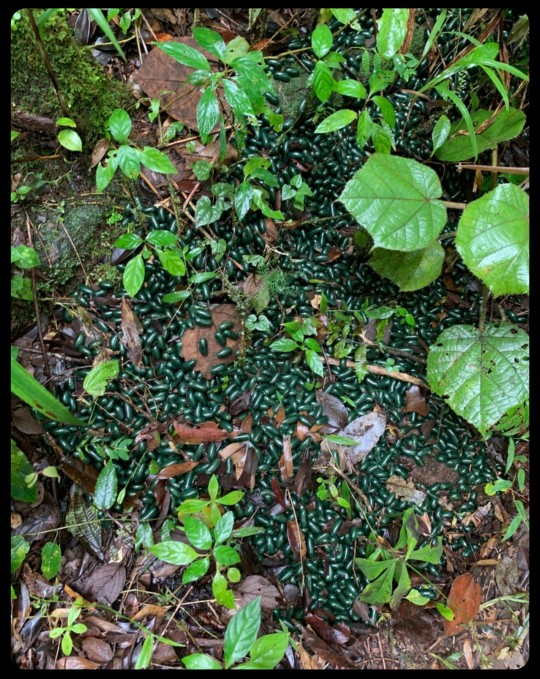
Important Note: I just want to remind everyone that these animals belong in their own natural habitat -- they should not be trapped, bought/sold, traded, shipped, collected, or kept as pets. This particular species does not survive well in captivity, either, and the demand for these "exotic" invertebrates is putting the wild populations in jeopardy. The previous article discusses those issues, too:
Another possible threat for Z. neptunus swarms are collections for the pet trade. There exists a large demand in Japan, Europe and North America for 'green -eyed monsters’ as pets. Giant pill -millipedes from Madagascar unfortunately have a very short survival time in terraria. The species is specialized on low-energy food (dead leaves), and adapted to the cool climates (<20°C) of the highlands. Specimens in terraria often starve to death quickly.
So I know that they're adorable and really, really fascinating...but let's just let them be their chunky, adorable little selves out in the wild where they belong.
Sources & More Info:
European Journal of Taxonomy: Seven New Giant Pill-Millipede Species and New Records of the Genus Zoosphaerium from Madagascar
Madagascar Conservation & Development: Swarming Behavior in the World's Largest Giant Pill-Millipede, Z. neptunus, and its Implication for Conservation Efforts
Bonn Zoological Bulletin Supplementum: The Giant Millipedes, Order Sphaerotheriida (an Annotated Species Catalogue) (PDF)
African Invertebrates: Madagascar's Living Giants: Discovery of Five New Species of Endemic Giant Pill-Millipedes from Madagascar (PDF)
#arthropods#giant green pill-millipede#zoosphaerium neptunus#myriapods#diplopoda#millipedes#island gigantism#entomology#evolution#malagasy#cool animals#bugs#insects#animal facts#madagascar#pill-millipede#pill bugs#but not really#Tainkintana#conglobation#swarming#conservation#giant emerald pill-millipede
168 notes
·
View notes
Text
Myriapoda Poll Round 3
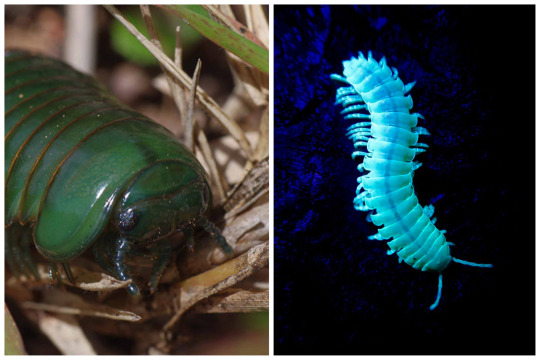
#myriapoda poll#giant emerald pill millipede#sierra luminous millipede#millipedes#diplopoda#arthropods#myriapoda#bugs#bugblr#entomology#polls
1K notes
·
View notes
Text
HEY GUYS I NEED HELP!
I recently came into the possession of a giant millipede, multiple small millis, and twenty or so (probably more...) isopods. About 10 of them are giant canyon isopods. PLEASE HELP ME LEARN HOW TO CARE FOR THEM!
If you have any care tips pls lmk!!! I'm very new to taking care of insects and such but I have done much of my own research on how to care for them.
Currently I have all of these guys in a 15 gal tank, a heater pad is attached to one side, the soil is at an angle, lots of leaf litter and a good amount of moss, some cork and rotting wood bark, a little cork log, and a shallow water source incase it gets too dry.
I also have a humidity and temp reader I got from Runnings. I've been giving them ground up egg shells for calcium and some potatoes peels and a cucumber slice for extra nourishment.
The layers in the tank are as follows:
- some small pebbles for drainage
- coco coir
- mixture of peat-based substrate from the store, some work casting organic fertilizer, and more coco coir
- leaf litter and moss
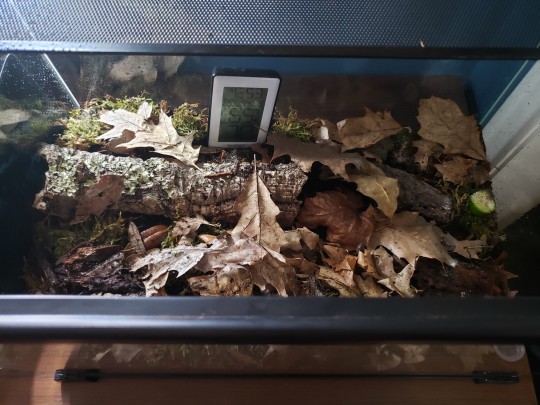
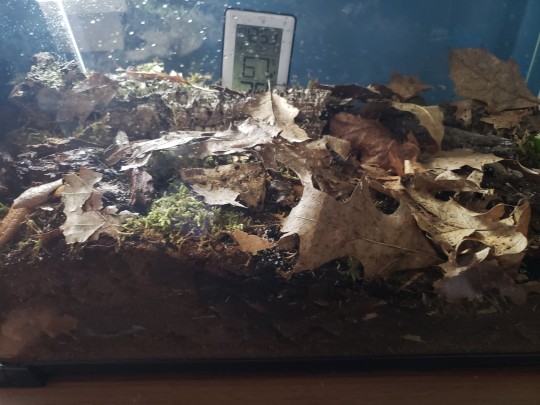
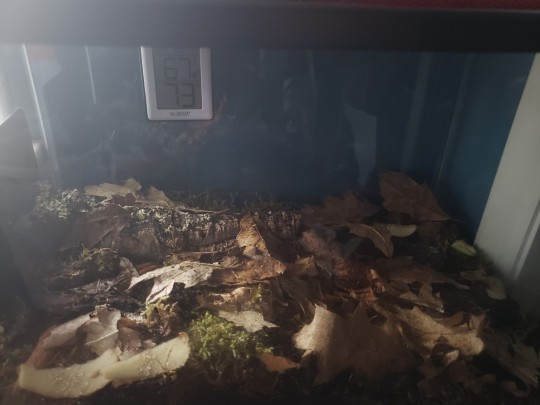
This is what it looks like ^^
It's placed in a generly dark area.
The millipedes name is Cranberry btw!!
(tw sh scars)
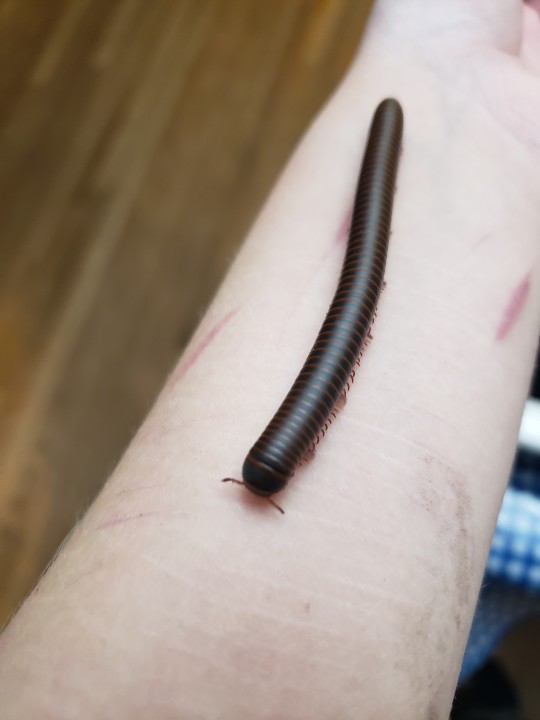
And these are the little goobers:
QUESTIONS I HAVE:
- How many insects can I put in one 15 gal tank?? How many isopods? Are there issues between them coexisting? I heard eggs might get eaten and if they aren't fed enough calcium they will try to eat eachother.
- Am I grinding up the egg shells enough? Are the peices too big? When I have the money I might just get cuttlefish bone but it can get pricy.
- How often should I clean??? I heard somewhere once a month but if it's a terrarium and not a singular creature and it's more of an ecosystem should I leave it alone other than feeding and spraying water n stuff?
- Can/should I put earthworms in the terrarium? What about snails/slugs? Would they be harmful or helpful?
UPDATE 5/11/24:
- I found a tiny spider guy in there. Is he chill??
#isopod#giant canyon isopod#millipede#millipedes#american giant millipede#help#terrarium#new terrarium owner#pill bugs#rolly polly#insects#bugs#critters#creatures#inverts#invertiblr#invertebrates#tw sh scars#sh scars#trigger warning#tw bugs#tw insects#animals#questions#care
25 notes
·
View notes
Text
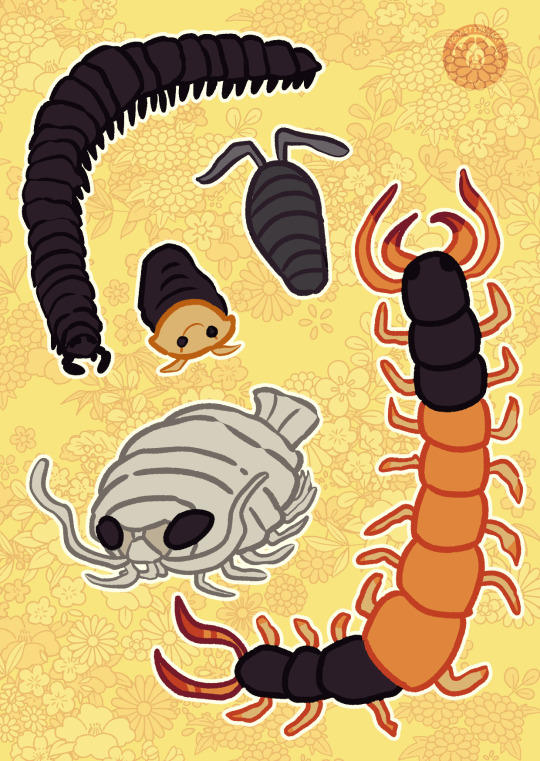
wonderful myriapods
Follow the Kickstarter Project
Ko-Fi / Patreon / Store
#illustration#digital art#animals#myriapod#millipede#centipede#isopod#rolypoly#giant african millipede#giant desert centipede#giant sea isopod#rubber ducky isopod#pill bug isopod#character art#stickers#sticker sheet#clip studio paint#nature
13 notes
·
View notes
Text

Giant Pill Millipede (Arthrosphaera fumosa), family Arthrosphaeridae, Talakaveri, Coorg, in the Western Ghats of India
photograph by L. Shyamal
2K notes
·
View notes
Text

Integrative taxonomy reveals two new giant pill-millipedes of the genus Zephronia Gray, 1832 from eastern Thailand (Diplopoda, Sphaerotheriida, Zephroniidae)
Ruttapon Srisonchai, Natdanai Likhitrakarn, Chirasak Sutcharit, Thomas Wesener
Abstract
A large amount of material of the millipede genus Zephronia Gray, 1832 was collected during 2014–2023 from many parts of eastern Thailand. An integrative study of morphological characters and genetic data (COI gene) revealed two new species: Z. chantaburiensis Srisonchai & Wesener, sp. nov. and Z. macula Srisonchai & Wesener, sp. nov. The two new species clearly differ from other congeners by their unique characteristics, especially in their colour pattern and telopod shape. The interspecific genetic distances of the 658 bp COI gene barcoding fragment between these new species and all other species of giant pill-millipede from Thailand, Laos and Cambodia are 12.01–23.49% for Z. chantaburiensis sp. nov. and 17.93–25.13% for Z. macula sp. nov. While relationships among species remain preliminary, the phylogenetic tree shows that species of Zephronia are interspersed with species of Sphaerobelum Verhoeff, 1924 and Prionobelum Verhoeff, 1924. Phylogenetic analyses place both new species in a clade termed Zephronia s.s., which receives support also from morphological data, showing a unique position of the organ of Tömösváry. Z. macula sp. nov. appears to occur over a broad distribution whereas Z. chantaburiensis sp. nov. was found only at the type locality. Given that all known records are in the eastern part of Thailand, we thus regard both species as endemic. Morphological illustrations based on SEM micrographs and a distribution map are also provided.
Read the paper here:
Integrative taxonomy reveals two new giant pill-millipedes of the genus Zephronia Gray, 1832 from eastern Thailand (Diplopoda, Sphaerotheriida, Zephroniidae) (pensoft.net)
211 notes
·
View notes
Text


#animal polls#poll blog#my polls#bugs#bugblr#pill millipede#millipede#arthropoda#myriapoda#animals#animal#Sphaerotheriida
145 notes
·
View notes
Text
Round 2 - Arthropoda - Diplopoda




(Sources - 1, 2, 3, 4)
Animals in the class Diplopoda are commonly called “Millipedes.” They comprise the orders Glomeridesmida (“Slug Millipedes”), Glomerida (“Northern Pill Millipedes”), Sphaerotheriida (“Giant Pill Millipedes”), Platydesmida (“Flat Millipedes”), Polyzoniida (“Camphor Millipedes”), Siphonocryptida, Siphonophorida, Julida, Spirobolida, Spirostreptida, Callipodida, Chordeumatida (“Sausage Millipedes”), Stemmiulida, Siphoniulida, Polydesmida, and Polyxenida (“Bristly Millipedes”).
Millipedes are detritivores, eating decaying leaves and other dead plant matter, making them important for cycling soil. Some species eat fungi or drink plant sap. Most species protect themselves with various chemical secretions, but they will also coil into a ball to protect their legs and vital areas when threatened. Polyxenids lack poison and a hard exoskeleton, so their defense involves barbed hairs that detach and stick to the mouths of predators.
Millipede heads are generally round and flattened, consisting of a pair of mandibles, a plate-like “jaw lip” called a gnathochilarium, a pair of small sensory antennae, and simple compound eyes. Some species have secondarily lost these eyes. Many species also have a pair of sensory organs called the Tömösváry organs at the bases of their antennae, which may measure humidity and/or light levels. Millipede bodies may be flattened or cylindrical, and they can be anywhere from 2 mm (1⁄16 in) to 35 cm (14 in) in length, and have from 11 to over 300 body segments. The segment behind their head is called a collum and is legless. The second, third, and fourth body segments are called haplosegments, and each have a single pair of legs on their underside. The remaining segments are called diplosegments and have two pairs of legs each. In some millipedes, the last few segments may be legless. The final segment is called the telson. It is always legless, and contains the anus. Some millipedes (those in the superorder Nematophora) have spinnerets as well, creating silk chambers in which to molt or lay their eggs. Though their name means “thousand feet”, only one species of centipede, Eumillipes persephone, has over 1,000 feet.
Millipede reproductive behavior is diverse. Bristle millipedes reproduce similarly to centipedes: depositing spermatophores onto webs they secrete, which are later picked up by females. Other millipedes have direct reproduction, meeting up to mate. Courtship may involve tapping antennae, the male running along the back of the female, offering gifts of edible glandular secretions, or even “chirping”. Males have one or two pairs of modified legs called gonopods which are used to transfer sperm to the female during copulation. A few species are parthenogenetic, having few, if any, males. Most species simply deposit their eggs on the ground, but some construct nests of dried feces or silk. In most species, the female abandons the eggs after they are laid, but some species do provide parental care for their eggs and young. Young millipedes usually hatch after a few weeks, bearing typically only three pairs of legs. Their development is anamorphic: adding on segments and legs with each moult. Some species can live up to 10 years.
Millipedes first appeared in the Silurian period. The most famous extinct millipedes, the genus Arthropleura of the Carboniferous, grew up to 2.5 metres (8 ft 2 in) long, making them some of the largest arthropods ever known.

Propaganda under the cut:
What is the difference between centipedes and millipedes? Centipedes are if a tiger was small, long, and venomous. Millipedes are if a cow was small, long, and poisonous. Hope that helps.
Mentioned above, Eumillipes persephone can have over 1,300 legs!
Millipedes have a vast array of chemical poisons to ward off predators, varying between genera. Polydesmid Millipedes produce Hydrogen cyanide. Motyxia species not only produce cyanide, but are also bioluminescent.
Despite their chemical defenses, many species prey on millipedes, some even benefiting from the poisons. Some poison dart frogs eat millipedes, converting their toxins into their own poison. Some lemurs use millipedes to self-medicate against parasites, or just to get high!
Many species have formed symbiotic relationships with millipedes. Some millipedes live only in ant colonies, while many mites use millipedes for transport to new areas. The Moss Millipede (Psammodesmus bryophorus) grows multiple species of moss on its back for camouflage, subsequently aiding the moss in dispersal.
41 notes
·
View notes
Text

Spectmeber 2024 Day 23: Royal Dragon-Skink
The Royal Dragon Skink is a ferocious inhabitant of the oak forests and open woodlands that stretch around the eastern and western halves of Jariloia. At 13 meters long and 4 tons in weight, it is the largest and heaviest member of Potworia’s diverse Dragon-Skink family or Smoksauridae, which are themselves distantly related to Earth’s Egerniinae, and is a usually slow-moving ambush predator that can sprint at short bursts of speed to overwhelm prey animals such as deer-pigs, juvenile or subadult Testudotitans, pig-sized ground beetles and giant hard-shelled pill-millipedes and clamp them down to smithereens with the use of massive, toothy jaws that are strong enough to crush bones, exoskeletons or shells and thus generate a bite force comparable to that of Tyrannosaurus rex. Like a few other members of the Smoksauridae, the Royal Dragon-Skink’s tail houses fat reserves that enable the giant lizard to survive the harsh dry season and go without water for a few weeks until the wet season begins.
#speculative#speculative biology#speculative evolution#speculaitve biology art#speculaitve evolution art#speculative zoology#spec bio#spec evo#spec zoo#spectember#spectember 2024
29 notes
·
View notes
Note
my lovely partner is originally from vietnam, and i've been dying to go to visit his family there. i've never EVER been to a jungle before and am SO excited for all the fauna i might encounter. do you have any favorite critters that i should keep an eye out for there? (near hanoi)
it’s a jungle you’ll surely see some wonderful bugs even without looking for them! big millipedes, pill millipedes, big katydids, raspy crickets, all sorts of colorful moths, huntsman spiders… plenty of things to find
but if you like centipedes as much as I do then that part of Vietnam has several beautiful morphospecies of Thereuopoda, including this gorgeous black one:
the Scolopendra there seem to be the chunky dirt-dwelling multidens, a personal favorite of mine but not terribly colorful.
your partner is probably not from a mountaintop, but if you do get the chance to visit some of the hills north of Hanoi, there’s a possibility you could find the most beautiful centipede in the world, Scolopendra “Mint Legs”.
86 notes
·
View notes
Note
Wait you should tell me (and everyone else reading this) all about your favourite bugs :] please :]

HIFUDHHHHHIOOOOOUGHHHH BUGS. OUGHH BUGS. INSECTS AND SPIDERS AND ROLLIE POLLIES AND SLUGS AND SNAILS!!!
They're quite possibly my favorite types of animals on this planet. I think they're only tied with marine life, cuz I love those guys as well. Seriously, my mom nicknamed me Bug because when I was a baby, i was "as cute and snug as a bug." And then I grew up to love bugs so it FIT!! Heck my dad shared some photos of a spider and I instantly went "YOOO CATS FACE SPIDER!!" They legitimately look like they have a cartoon kitty face for an abdomen. They're such a brilliant and amazing orange, and they're just cute! They're also a type of orb weaver. And orb weavers can get HUGE
Speaking of spiders, a couple that you DO actually want in your home are wolf spiders and jumping spiders. They don't make webs, they're often born outside so they're capable of just being let out, and they'll just eat the bugs and pests in your home and leave. I am not kidding, I have never seen a jumping spider stay in one person's house longer than three days.
Rollie pollies (or pill bugs, potato bugs, isopods) are actually crustaceans. Rrlated more to crabs and lobsters. Have ya ever heard of the giant isopod in the deep? Yeah! THEY'RE COOL HUH? They're also neat little scavengers and will eat almost anything, especially dead and rotting leaves and plants. Mostly those. They also live in large families and hibernate.
Dragonflies are just cool. I love calling them helicopters cuz they are just that. Being able to zip up and down and backwards and forwards and hover. They're also predators, meaning they hunt other bugs. And the bigger ones have quite a bite. Ask me, the local bug handler, how I know that bfiejdj
I don't have much info on millipedes and centipedes. They're just cool. Though you've got to be careful when handling centipedes. Those things are venomous, and some can even deliver a VERY nasty bite. I haven't been bitten by one that's dangerous to humans, but yeah. They've got a strong bite.
Speaking of strong bites, or pincers, I STILL CAN AND WILL DEFEND EARWIGS. They are COOL. They have a PINCER on their BUTT. I have seen albino ones where they're just pure white. Yeah they can get a bit stinky but thats also pretty cool imo (says the one who spent hours hunting for bugs fiejdjw). They don't crawl in your ears at all. I'm sure if they were called something different, they'd be less hated. Also cockroaches are neat, fite me.
Pelican spiders is quite possibly the most ridiculous spider I have ever seen. And I've seen ogre-faced orb weavers and those spiders with smiles on their abdomen. They're a more ancient species of spider where their long fangs are used more as an assassin thing. Pretty cool right? Man that spider can PELICAN. (Seriously look these guys up I love them SO MUCH)
Deaths head hawkmoths are probably my favorite moths. They're pretty big and can squeak (did you know that certain bugs, such as moths and beetles, can squeak? Yeah! Moths do it by pushing air out their proboscus and the beetles that squeak have large mandibles). Deaths head moths have a skull-like pattern on their thorax and they're just GORGEOUS. I love them. Also look up rosy maple moths! I love moths!
Honeybees are pretty docile and can be picked up and even pet. I've pet a few bees. Also wasps are cool. They're just gorgeous to me. A lot of the time, just leave em be. Hold still while they're around you, don't be afraid of them, and they'll buzz off. Yellow jackets do this anyway. They don't really hunt humans unless you did something to their hive
Anyways I'm. I've done a lot of bug facts. Have fun with these!!
5 notes
·
View notes
Text
RESULTS ARE IN

GIANT EMERALD PILL MILLIPEDES ARE THE WINNERS!
125 notes
·
View notes
Text
God may be real but he is also cruel bc tell me why I cannot go out and hug a giant emerald pill millipede rn. Tell me why I can’t hug the friend sized green pillbug with too many leggies. Explain urself. What was your thought process here. I am going to bite you.
5 notes
·
View notes
Note
what are your top ten bugs










tarantulas that are also orange
big ass beetles
sphinx moths
redworms and other assorted earthworms
PILL BUGS
the noble owl butterfly
stick insects
giant millipedes
bagworms
leafcutter ants
bees are not on the list because then I would just list 10 species of bees and there would be no variety there. I love every bee on earth, they are like people to me.
#ask#bugs cw#spiders cw#beetles cw#worms cw#insects cw#covering all my bases for those who have these tags blocked
17 notes
·
View notes
Text

Giant Emerald Pill Millipede (Zoosphaerium neptunus), family Anthrosphaeridae, Alaotra-Mangoro, Toamasina, Madagascar
Photograph by Julien Renoult
#pill millipede#millipede#myriapod#zoosphaerium#anthrosphaeridae#nature#animals#madagascar#entomology
573 notes
·
View notes